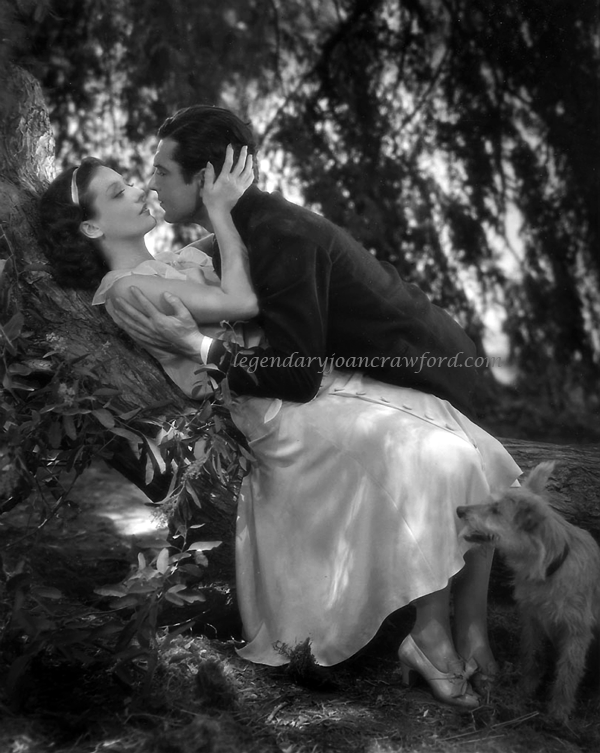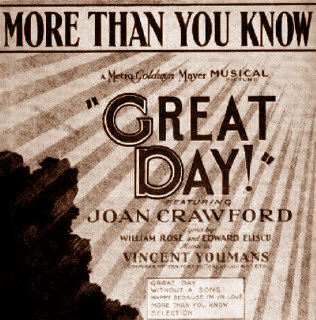|

"I viewed the rushes with mounting concern - they were God-awful." - Joan Crawford
"Great Day" 1930
Cast: Joan Crawford, Johnny Mack Brown, John Miljan, Anita Page, Marjorie Rambeau
Release date - September 1930
Running Time - Unfinished Production
Director - Harry Beaumont
Writing Credits - Unknown
Studio - MGM

Interesting Trivia
"Great Day" is one of those mystery productions that was started and shut down before its completion. The film was
very close to completion, but the studio, and Joan, supposedly didn't like what they were seeing. They mutually decided to
go into major rewrites to save the film with the plan to go back to shooting with the newly revised script by the following
year, in 1931. It never happened and "Great Day," was never released. However, there seems to be a much bigger story
to the movie that never was. Tantalizing references to "Great Day" are out there, but anyone researching it finds
there are many dead ends. It's as if someone had tried to erase its existence. And there's a very good reason for that - someone
did.
"Great Day" began as a Vincent Youmans musical purchased by M-G-M to be tailored to Joan Crawford's talents.
The 1929 show had not been a success on Broadway, lasting only twenty-nine performances. But its songs (with lyrics by Billy
Rose and Edward Eliscu) had been memorable. They included the title tune, another called "Without A Song", and
lastly, one of the all-time standards, "More Than You Know." It was the popularity of the music that encouraged
MGM to buy the rights for the film version.
Sometime in September of 1930, "Great Day's" shooting began, the cast included Joan Crawford, Johnny Mack Brown,
John Miljan, Anita Page, and Marjorie Rambeau. MGM had begun publicising the movie, with mentions in fan magazines and newspapers,
and a release of the movie's songs in the form of sheet music heralding the film, complete with Crawford's name and the MGM
logo. Takes were made, on-set stills taken; at least three scenes were worked on - and then it all collapsed. "Great
Day" was cancelled - unheard-of for a Crawford production - its cast dismissed, its sets dismantled. It literally disappeared.
For years, "Great Day" was referred to only briefly, if at all, in Joan's filmographies. One of the strangest
facts surrounding the film was that all MGM production records for this "A" feature had disappeared, yet, records
for many other uncompleted movies had survived. Why?
Unlike Crawford's other pictures at this period, "Great Day" was not assigned to a run-of-the mill M-G-M producer.
This was an Irving Thalberg movie, and the significance of that can hardly be overestimated. He was MGM's "boy wonder."
Because it was a Thalberg production, it would have been planned to cost more from the beginning, to shoot longer, to get
extra care and attention at every phase of production. Thalberg was a perfectionist, that trait often cost the studio a lot
of money, and it wasn't always a great box office return on their investment. "Great Day" was Thalberg's first request
for Joan's services in a film that he personally supervised. Thalberg's attention to quality would likely have been perceived
as "Great Day's" strength. Ironically, it appears it was the reason for the film's downfall.
Unbeknownst to the public, Joan was holding a mighty big grudge against Irving Thalberg. Joan had suffered a grievous
professional loss at Thalberg's hands earlier that same year. One of the decade's hottest - in several senses of that word
- properties had been purchased with Joan in mind. It was called "Ex-Wife," a 1929 book so racy that author Ursula
Parrott published it anonymously for fear of the backlash it would surely receive with the puritanical public of the day.
MGM paid a record breaking (for the time) $20,000 for the film rights. By 1930, Joan was MGM's biggest money making star
and she excitedly waited for things to get started on a role that would most certainly make the world sit up and take notice.
She waited in vain.
Another actress had her eye on "Ex-Wife," and unfortunately for Joan's aspirations, it was the one MGM star
who actually had a chance of wresting Joan's prize away from her - Norma Shearer. Shearer was Irving Thalberg's wife, and
her interest altered more than one equation for the planned film. At first, it did not seem a project suited to Shearer. Norma
herself described the "Ex-Wife" part she wanted as "Very strong, almost ruthless," but lamented, "Irving
won't give me the part, because he doesn't think I'm glamorous enough." To be fair to Thalberg, his concerns seem to
have been based in Shearer's "ladylike" appearance and image; the role called for men to lose their heads over her
through sheer lust. Always one to find a way past difficulties, Norma Shearer tackled her husband's opposition head-on, by
going to a new photographer, one outside the MGM system, for some photographs that she felt would change Thalberg's mind.
The photographer was George Hurrell, and the results of that famous sitting were just as "hot" as "Ex-Wife"
itself. Norma had chosen a gold lamé robe that tended to fall open provocatively, and Hurrell had directed the hairdresser
Norma had brought to "loosen up" her hairstyle. The result was a completely new Shearer with a previously undreamt-of
sexual gloss. Norma triumphantly took the pictures to her husband, threw them on his desk, and asked, "Now do you believe
I can play a femme fatale and leave them crying for more?" Electrified by what he saw, Thalberg gave his wife the role.
Re-titled "The Divorcée," the sizzling movie was one of 1930's biggest hits, bringing a whole new fan base to Shearer,
and winning her that year's Academy Award for Best Actress.
Despite all the respectful MGM publicity about Thalberg and his star-studded movies, Irving had gained himself a powerful
enemy at the studio, Louis B. Mayer. Formerly Thalberg's friend and booster, Mayer had tired of what he viewed as "the
tail wagging the dog." Thalberg had also interfered with Mayer's desires for studio profits, by mounting expensive productions
that didn't always earn as much as they should have, given the amount of investment. While M-G-M was certainly able to afford
Thalberg's "prestige pictures" up to a point, Mayer didn't feel he could; his job (and the part of his compensation
based on profit-sharing) was contingent on profitability. Thalberg's expensive quest for quality interfered with that; it
was actually costing Mayer money. The two executives had been at loggerheads for some time, and Mayer could have seen "Great
Day" as just the opportunity he needed to begin reining Irving in.
Conceivably, Joan Crawford may have given a bad performance to scuttle Great Day of her own accord, as payback to Thalberg
for handing Norma Shearer an Oscar on a silver platter. She may also have given that bad performance at Mayer's request, to
settle both her score and L.B.'s. There are many clues; Crawford herself said, "I viewed the rushes with mounting concern
- they were God-awful." In her own book, "A Portrait of Joan," Crawford says that she went to Mayer, who also
viewed the rushes, agreed with her self-assessment, and ordered the movie shut down.
Joan went on to make "Dance, Fools, Dance," another formula film in which she had a dance number, and which
earned the kind of money expected of Joan's pictures. Mayer went on to maintain his position as head of MGM for almost twenty-years
more, at which time he was himself ousted, and replaced with Dore Schary. Norma Shearer actually benefited from her husband's
eventual reduction in status at the studio. Thalberg was freed from responsibility for anything but his own movies, so he
concentrated on making his wife one of MGM's most prestigious stars. Joan did finally star in a Thalberg movie, 1932's "Grand
Hotel," getting rave reviews in a mega all star hit.
Irving Thalberg was a consummate Hollywood player; he handled Mayer's 1933 ouster of him by telegram with respectful silence.
He continued his european vacation, later returning to Hollywood and his new position at the studio as if nothing had ever
happened.
Irving Thalberg was a sickly child and he was constantly in a weakend condition as an adult. He died of lobular pneumonia
six years after the "Great Day" debacle (September 14, 1936). He was thirty-seven years old. Despite his apparent
fall out with Mayer, on the day of his funeral, MGM closed for the entire day, and every Hollywood studio shut down operatons
for five minutes of silence at 10:00AM PST.
Owing to Thalberg's habit in his lifetime of not seizing the spotlight for himself, Hollywood's memorials to him after
his death were relatively sedate, although heartfelt. MGM renamed their administration facility the Thalberg Building, and
the Academy of Motion Picture Arts & Sciences created the Thalberg Award to acknowledge "Creative producers, whose
bodies of work reflect a consistently high quality of motion picture production
Photos
Click on images below to see a larger view.
Click on the decades below to browse movies.
|

